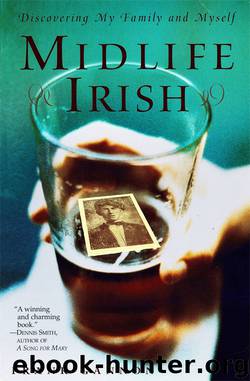Midlife Irish by Frank Gannon

Author:Frank Gannon [GANNON, FRANK]
Language: eng
Format: epub
ISBN: 9780446567275
Publisher: Grand Central Publishing
Published: 2009-10-31T04:00:00+00:00
Exiles for Christ
In the Irish countryside one can still find the little solitary cells that men like Saint Columba inhabited. Holy men, men who removed themselves from the world and helped establish the Catholic Church in Ireland, lived in these cells. They were called “exiles for Christ.”
If you walk into one of these today, it is easy to imagine what men like Patrick and Columba felt. They had chosen to spend their whole lives in these little cells, isolated from friends, family, the world. Considering these men, I had an overpowering feeling of the transitory, brief nature of human life. Ireland was becoming, for me, a sort of “God’s waiting room.” I wasn’t hurrying death, but I was aware of it as I had never been. I thought of some lines I hadn’t thought about since college, from Yeats:
A man awaits his end
Dreading and hoping all
In Ireland the spiritual always seemed very close. I realized that I hadn’t thought anything about my own death since I was a kid. Ireland didn’t take me away somewhere; it just brought me home. I seemed to be unable to think without thinking of “the big picture.” I was now thinking Irish.
For the Irish, literacy was almost equivalent to religion. From the beginning, the idea of learning was completely intertwined with religion in Ireland. The leading intellectuals were all monks, and the advanced schools shared their names with monasteries. On the surface Ireland’s collective consciousness was now Christian. But a little bit of the “old ways” still hung on. The Catholic Church as an institution was, of course, centered in Rome. But you never get a sense that the early Roman Church somehow interposed itself in Ireland. Despite the formalities and dogma and rituals of a very organized hierarchical Catholic Church, Christianity in Ireland was a quite distinct thing. No one would have a hard time distinguishing between “Irish Catholicism” and “Roman Catholicism.” In Columba’s life and writings, you can see that calling the Catholic Church in Ireland “the Irish Church” was not a big stretch.
But the Church in Ireland was still the same Latin-based religion with precise strictures, and the Irish bishops kept the “Roman rules” in a hard-nosed fashion. The ritual and dogma stayed almost precisely the same as in Rome. The dates for feast days were slightly different (owing to the Irish adherence to tradition and a spirited defense of “the Irish Way” by Irish bishops, notably Columbanus, who butted heads, quite successfully, with Pope Gregory the Great).
In the early Catholic Church, there was a real fear of classical learning. The entire liturgy was written in Latin, the language of Nero and Commodus, and there is, throughout the Irish clerical writing of the era, an oft-stated warning, a great fear of somehow being swayed toward pagan ways. Since the early Irish Church hung on to a lot of pagan trappings, maybe the fear was well founded.
You find writings warning of “the temptation of grammar and the lure of Apollo.” But in Ireland, the monks seem to have taken to Latin in a very serendipitous way.
Download
This site does not store any files on its server. We only index and link to content provided by other sites. Please contact the content providers to delete copyright contents if any and email us, we'll remove relevant links or contents immediately.
Becoming by Michelle Obama(9286)
The Last Black Unicorn by Tiffany Haddish(5065)
Beartown by Fredrik Backman(4403)
Man's Search for Meaning by Viktor Frankl(3620)
The Book of Joy by Dalai Lama(3212)
In a Sunburned Country by Bill Bryson(2941)
The Choice by Edith Eva Eger(2894)
The Five People You Meet in Heaven by Mitch Albom(2833)
Full Circle by Michael Palin(2764)
The Mamba Mentality by Kobe Bryant(2665)
The Social Psychology of Inequality by Unknown(2304)
Book of Life by Deborah Harkness(2258)
The Checklist Manifesto by Atul Gawande(2199)
Less by Andrew Sean Greer(2183)
The Big Twitch by Sean Dooley(2041)
No Room for Small Dreams by Shimon Peres(1985)
A Burst of Light by Audre Lorde(1978)
No Ashes in the Fire by Darnell L Moore(1976)
Imagine Me by Tahereh Mafi(1901)
